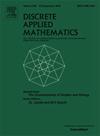最大次为3的图的优美着色
IF 1
3区 数学
Q3 MATHEMATICS, APPLIED
引用次数: 0
摘要
图G的优美k-着色由一个适当的顶点着色f:V(G)→{1,…,k}组成,该着色诱导出一个适当的边着色。在这种情况下,分配给边uv∈E(G)的颜色由分配给顶点u和v的颜色之差的绝对值决定。图G具有优美k着色的最小k是G的优美色数,用χg(G)表示。本文根据任意图的最大次Δ,建立了图的优美色数的第一个已知上界,即证明了图的优美色数满足不等式χg(G)≤5Δ2−3Δ2+1。该结果提供了完全图Kn的χg(Kn)的第一个上界,并且比Bi等人(2017)对规则完全k-部图Kk(p)的先前发现有所改进。我们证明了判定图G是否有优美5色问题的np完备性。进一步,我们将研究扩展到次三次图,建立了无最大次相邻顶点的次三次图族优美色数的上界。此外,我们还确定了两类三次图的优美色数,即Flower snks和Goldberg snks。本文章由计算机程序翻译,如有差异,请以英文原文为准。
Graceful colorings of graphs with maximum degree three
A graceful -coloring of a graph consists of a proper vertex coloring that induces a proper edge coloring. In this case, the color assigned to an edge is determined by the absolute value of the difference between the colors assigned to vertices and . The minimum for which a graph has a graceful -coloring is the graceful chromatic number of , denoted by . In this paper, we establish the first known upper bound for the graceful chromatic number of an arbitrary graph, in terms of its maximum degree , i.e., we prove that the graceful chromatic number satisfies the inequality . This result provides the first upper bound for of complete graphs , and represents an improvement over a previous finding by Bi et al. (2017) for regular complete -partite graphs . We demonstrate the -completeness of the problem of determining whether a graph has a graceful 5-coloring. Furthermore, we extend our investigation to subcubic graphs, establishing upper bounds for the graceful chromatic number of families of subcubic graphs without adjacent vertices of maximum degree. Additionally, we determine the graceful chromatic number for two cubic graph classes, namely Flower snarks and Goldberg snarks.
求助全文
通过发布文献求助,成功后即可免费获取论文全文。
去求助
来源期刊

Discrete Applied Mathematics
数学-应用数学
CiteScore
2.30
自引率
9.10%
发文量
422
审稿时长
4.5 months
期刊介绍:
The aim of Discrete Applied Mathematics is to bring together research papers in different areas of algorithmic and applicable discrete mathematics as well as applications of combinatorial mathematics to informatics and various areas of science and technology. Contributions presented to the journal can be research papers, short notes, surveys, and possibly research problems. The "Communications" section will be devoted to the fastest possible publication of recent research results that are checked and recommended for publication by a member of the Editorial Board. The journal will also publish a limited number of book announcements as well as proceedings of conferences. These proceedings will be fully refereed and adhere to the normal standards of the journal.
Potential authors are advised to view the journal and the open calls-for-papers of special issues before submitting their manuscripts. Only high-quality, original work that is within the scope of the journal or the targeted special issue will be considered.
 求助内容:
求助内容: 应助结果提醒方式:
应助结果提醒方式:


